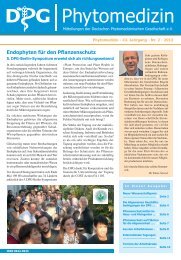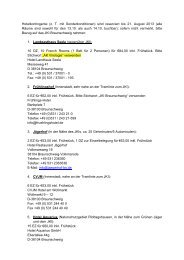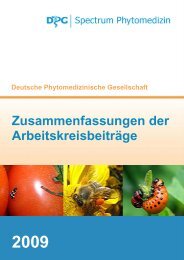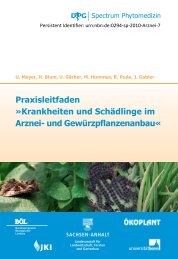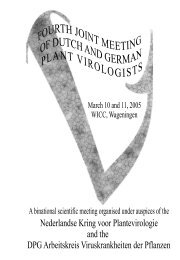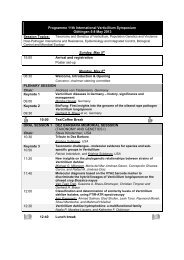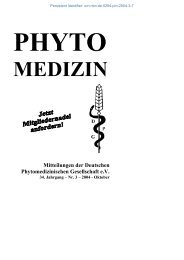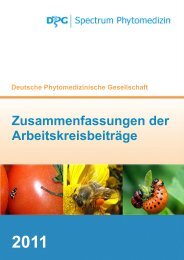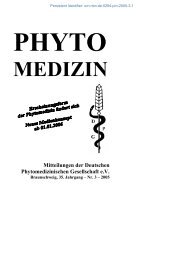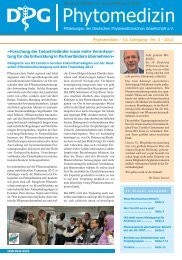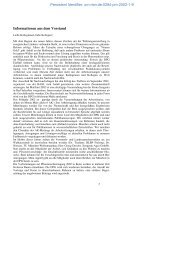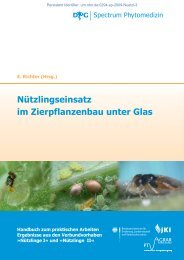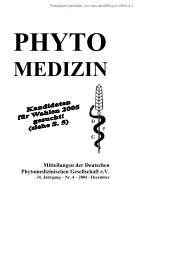PHYTO MEDIZIN Mitteilungen der Deutschen ... - Die DPG
PHYTO MEDIZIN Mitteilungen der Deutschen ... - Die DPG
PHYTO MEDIZIN Mitteilungen der Deutschen ... - Die DPG
Erfolgreiche ePaper selbst erstellen
Machen Sie aus Ihren PDF Publikationen ein blätterbares Flipbook mit unserer einzigartigen Google optimierten e-Paper Software.
Persistent Identifier: urn:nbn:de:0294-pm-2005-2-6<br />
Gemeinschaft hinwiesen, zeigten die Pseudomonas-spezifischen Gele eine<br />
deutliche Beeinflussung <strong>der</strong> relativen Abundanz von Pseudomonaden auch<br />
drei Wochen nach <strong>der</strong> Inokulation. <strong>Die</strong> CLSM-Untersuchungen zeigten eine<br />
recht heterogene Besiedlung <strong>der</strong> Wurzel für PRD16 und PRF116, wobei bei<br />
<strong>der</strong> Wurzelinokulation insbeson<strong>der</strong>e Bereiche <strong>der</strong> Wurzel besiedelt waren,<br />
die ursprünglich getaucht wurden. Aber auch nach drei Wochen waren einige<br />
dicht besiedelte Bereiche nachweisbar.<br />
Gomes N.C.M., R. Costa and K. Smalla. 2004. Rapid simultaneous extraction of<br />
DNA and RNA from bulk and rhizosphere soil. chapter 1.12: 159-169. In G. A.<br />
Kowalchuk, F. J. de Bruijn, I. M. Head, Akkermans, A.D.L., and J. D. van Elsas,<br />
editors.Molecular Microbial Ecology Manual, 2nd edition. Kluwer Academic Publishers,<br />
Dordrecht.<br />
Götz, M., N.C.M. Gomes, A. Dratwinski, R. Costa, G. Berg, R. Peixoto, L. Mendonça-Hagler,<br />
and K. Smalla. 2005. Survival of gfp-tagged antagonistic bacteria in<br />
the rhizosphere of tomato plants and their effects on the indigenous bacterial community.<br />
FEMS Microb. Ecol. Eingereicht.<br />
Peixoto, R., M. Götz, A. Milling, G. Berg, R. Costa, A. Rosado, L. Mendonça-Hagler,<br />
and K. Smalla. 2004. Monitoring GFP-tagged bacterial antagonists in the rhizosphere<br />
of tomato plants. In: Multitrophic Interactions in Soil and Integrated Control (Hrg.<br />
Sikora, R.A., Gowen, S., Hauschild, R., Kiewnick, S.), IOBC wprs Bulletin 27, 219-<br />
224<br />
Biological control of apple scab by application of non – pathogenic microorganisms<br />
to the plant phyllosphere of Malus domestica<br />
Kürkcüoglu, Sophia 1 ; Piotrowski Markus 2 ; Gau Achim 1 1 Institut für Botanik, Universität<br />
Hannover, Herrenhäuserstr. 2, 30419 Hannover, Germany; 2 Lehrstuhl für<br />
Pflanzenphysiologie, Ruhr-Universität Bochum, D-44780 Bochum, Germany, Email:<br />
kuerkcueoglu@aol.com<br />
The biological control of apple scab by application of antagonistic microorganisms<br />
to the plant phyllosphere is an alternative strategy to the frequent<br />
treatment of plants by fungicides. As known from the plant rhizosphere,<br />
where systemic accquired resistance can be induced by microorganisms, we<br />
assume a similar way of interaction in the phyllosphere of plants. Analyses of<br />
the protein composition of the apoplast by SDS-PAGE revealed dramatic<br />
changes after in-oculation by the non-pathogenic Pseudomonas fluorescens<br />
Bk3 to the phyllosphere of Malus domestica cv. Hosteiner Cox. Sequencing<br />
of the induced proteins by ESI-Q-TOF mass spectrometry and homology<br />
search identified these additional proteins as ß-1,3- glucanase, thaumatin-like<br />
protein, chitinase and hevein-like protein. In contrast, we found a non-<br />
6



